Curtisia dentata
Curtisia dentata (Burm.f.) C.A.Sm.
Family: Cornaceae
Common names: assegai (Eng.); assegaai (Afr.); uSirayi, umGxina (Xhosa); umLahleni (Xhosa, Zulu); uMagunda, uMaginda, umBese, umPhephelelangeni (Zulu); iliNcayi, isiNwati (Sw); modula-tshwene (Northern Sotho); musangwe, mufhefhera (Venda)
SA Tree No: 570
Introduction
Curtisia dentata is a handsome, evergreen tree with beautiful foliage that looks good throughout the year. It has great potential as a garden tree, an evergreen hedge and a timber tree.
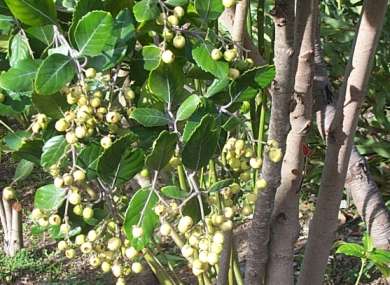
Description
Description
A medium to tall evergreen tree, 2-12 m and up to 20 m in height. The bark is smooth and grey or cinnamon-coloured in young specimens but it becomes rough, dark brown to black and deeply square-fissured with age. The leaves are simple, 25-100 x 19-76 mm, egg-shaped with pointed tips and coarsely toothed edges, and are arranged in opposite pairs. The leaf's upper surface is smooth and dark glossy green whereas the undersurface is grey-green with conspicuous veins. The undersurface of the leaf, the leaf stalk and the twigs are all covered with small, reddish hairs. Very young growth is velvety to the touch and bronze-gold in colour.
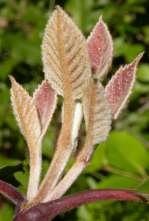
The flowers are inconspicuous, not very attractive nor are they scented. They are small, drab cream- or fawn-coloured and velvety and appear in much-branched sprays at the ends of twigs in spring-summer (Oct.-Mar.). They are often parasitized so that only a few produce seed.
The fruit is a small, rounded to oval, a fleshy berry, about 10 mm in diameter. They generally appear 6-10 months after flowering (May-Oct), and are white, or white tinged with pink, sometimes becoming red, and crowned with the remains of the calyx. The fruits contain a four-chambered nut, one seed per chamber, although not all four seeds are always formed. Fruits are edible but bitter. They remain on the tree for a long time and can be very decorative.
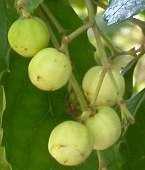
Distribution and habitat
Distribution description
The assegai grows in most of the forests in southern Africa and Swaziland, from sea level to 1 800 m. It ranges from the Cape Peninsula through the forest patches of the eastern Western Cape to the forests of the Knysna region, the Eastern Cape, KwaZulu-Natal, Mpumalanga, Limpopo and Swaziland. In the forest it is usually found in climax forest and grows into a tall tree with a clean, unbuttressed bole. It also grows on grassy mountain slopes and in coastal scrub forest where it is a small bushy tree.
Curtisia dentata trees are at their best in medium-moist forest, where they are found growing with Podocarpus latifolius (yellowwood) and Olea capensis (black ironwood). In the dry-type forest they are generally smaller, and in moist forest they are comparatively rare. They are also present in coastal and montane forests but do not reach as large a size as in the forests of the plateaux. It is never found in pure communities nor is it ever dominant or even co-dominant. Curtisia is capable of living in the dense shade of a natural forest, but young trees grow faster under higher light intensities.
Derivation of name and historical aspects
History
Curtisia is a genus of only one species. It belongs in the Cornaceae (dogwood family), a small family of about 15 genera most of which occur in the temperate parts of the northern hemisphere. The most well-known genus is Cornus, the decorative dogwoods. Curtisia is the only southern African member of the family, and has no close relatives in southern Africa. The family gets its name from its typically hard timber, from the Latin cornu meaning horn, alluding to the hardness of the wood.
Curtisia is named in honour of William Curtis (1746-1799), founder of Curtis's Botanical Magazine, first published in 1786 and still going today. The specific name dentata is Latin for toothed, and refers to the toothed leaves.
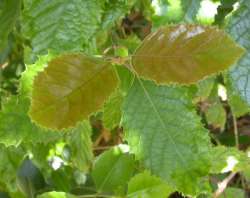
The common name assegai is derived from the Arabic name azzaghayah, that was adopted by the Portuguese, with various modifications of spelling, and taken over by the early Dutch writers. This name was already recorded, in modern spelling, in 1625, and in 1652 Van Riebeeck referred to hassegaayen used by the natives for spears and bows. It is commonly supposed that Curtisia dentata got this common name because the shafts of assegais were once made of the wood, as Thunberg wrote in 1774, 'The Assagay tree is used for poles of wagons and as shafts for the Hottentot's javelins' (Palmer & Pitman 1972). But some dispute this and think that the name is from the resemblance of the leaves to an assegai blade and that the assumption that the wood was used to make assegais comes from the name — something of a chicken-and-egg situation — which remains unresolved. Nevertheless, this name was first recorded for Curtisia dentata in 1662 in Wagenaer's forest survey which mentions hazegaijen boomen hout (Smith 1966).
To add a touch of romance to the debate, trees of this family have an ancient connection with spear-making. The shaft of the spear that Romulus flung towards the Palatine Hill when marking the boundaries of Rome is supposed to have been of a dogwood, popularly known as the cornelian cherry. By tradition, the Trojan Horse was also carved from this tree. So, trees of this family have had quite an impact on history, providing spears for Roman soldiers and possibly also African warriors, and shaping the history of Troy, and providing wood for the wagons that opened up the interior of South Africa.
Ecology
Ecology
Curtisia dentata retains its leaves for 2-4 or more years and does not create much leaf litter. It is storm-firm, because it is a deep-rooted species, it does not form a heavy crown and has remarkably tough branches that are rarely broken by severe winds.
The flowers are odourless and secrete no nectar. The honey-bee does not visit the flowers for pollen, nor do any other insects pay any serious attention to them. Pollination experiments and observations by Phillips (1928) have shown that the species is almost entirely self-pollinated, but cross-pollination by wind may take place. Flowers are produced every year, and fruits are usually formed 6 to 10 months later, although some years are bad years when the flowers are diseased by a gall-forming organism and fruit formation is very poor.
The fruits are bitter and are eaten by birds, bats, monkeys, baboons and wild pigs. The lourie and the bush dove appear to be the main agents of dispersal of the seed, but most of the seeds actually fall to the ground at the base of the parent. About 50% of the viable seeds that drop actually produce seedlings. In nature, the seeds normally germinate 6 to 12 months but never more than 15 to 18 months after the fruits drop, the delay probably being due to the time taken for the corky pericarp and the hard nut that encloses them to decay.
Turkey-tail bracket fungus attacks dead trunks and branches.
Uses
Use
The timber of the assegai is good, strong and durable and has been exploited since the earliest colonial days, particularly for wagon-making-so much so that thousands must have been felled and a well-grown mature tree is still uncommon in our forests. The timber is reddish, turning red-brown with age and somewhat resembles mahogany, and is extremely tough, strong and elastic with a fine grain. As dry assegai shrinks less than most other woods, it made the best spokes of any Cape wood, and was also valuable for felloes (curved strips joined together to form the rim of a wheel). It was also used by the Voortrekkers to make axles for their wagons, and was popular too for other wagon parts, tool handles, furniture, rafters and flooring.
The bark, twigs and leaves were once used for tanning leather.
The bark is in great demand for traditional medicine, and is used to treat stomach ailments, diarrhoea and as a blood purifier and aphrodisiac. It is used only in special mixtures because it is now too scarce to be used in most mixtures.
Growing Curtisia dentata
Grow
The assegai is handsome, fast-growing and easy to grow. It grows into a tall shapely, densely-leafy evergreen tree with a rounded crown that looks good all year round. It can be grown in full sun to light shade. In full sun it becomes bushy, and makes an attractive, tall, leafy hedge or screen. Its roots are non-invasive and it has a long lifespan, i.e. 30+ years. It is a good tree for gardeners wishing to attract birds to their garden.
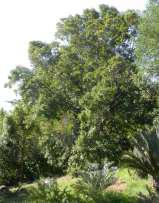
For best results plant it in deep, fertile soil with plenty of compost and water generously for the first 2 to 3 years. Apply compost at least on an annual basis, and a general fertilizer in spring. Although it prefers a warm, well-watered climate, once established it will withstand moderate drought. It is also sensitive to frost, young plants being killed and older plants temporarily defoliated. Established plants should survive moderate frost.
Curtisia dentata is best propagated by seed. Remove the fleshing covering of the berry and sow the nut when fresh, covered lightly and keep warm and moist. Germination takes 3 to 4 weeks. Seedlings are vigorous but highly susceptible to injury from drought, high surface soil temperature, frost and damping off fungi. They are thus best kept moist, but not wet, in light shade and protected from frost and full sun. The trays should be treated with a fungicide that combats damping off. Young saplings are also very sensitive to bright light, full sun will scorch the foliage and could even kill the young plant. Saplings are best grown in light shade; deep shade will also result in healthy plants but slower growth. Saplings are also sensitive to frost.
Cuttings do not strike adventitious roots readily, but cut stumps coppice freely and the roots give off suckers.
References
- Coates Palgrave, M. 2002. Keith Coates Palgrave Trees of southern Africa, edn 3. Struik, Cape Town.
- Germishuizen, G. & Meyer, N.L. (eds). 2003. Plants of southern Africa: an annotated checklist. Strelitzia 14. National Botanical Institute, Pretoria.
- Palmer, E. & Pitman, N. 1972. Trees of southern Africa. Balkema, Cape Town.
- Phillips, J.F.V. 1928. Curtisia faginea Ait. ("Assegaai"): an ecolgical note. Transactions of the Royal Society of South Africa 17: 19-42.
- Smith, C.A. 1966. Common names of South African plants. Memoirs of the Botanical Survey of South Africa No. 35. Department of Agricultural Technical Services, Pretoria.
- Van Wyk, B-E., Van Oudtshoorn, B. & Gericke, N. 1997. Medicinal plants of South Africa. Briza Publications, Pretoria.
Credits
Alice Notten
Kirstenbosch National Botanical Garden
July 2004
Plant Attributes:
Plant Type: Tree
SA Distribution: Eastern Cape, KwaZulu-Natal, Limpopo, Mpumalanga, Western Cape
Soil type: Loam
Flowering season: Early Summer, Late Summer
PH: Acid
Flower colour: Cream
Aspect: Full Sun
Gardening skill: Easy
Special Features:
Horticultural zones










Rate this article
Article well written and informative
Rate this plant
Is this an interesting plant?
Login to add your Comment
Back to topNot registered yet? Click here to register.